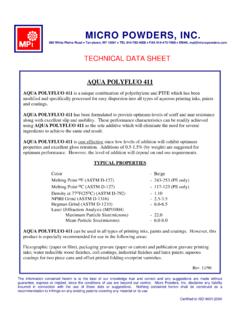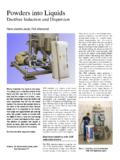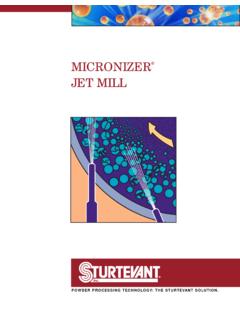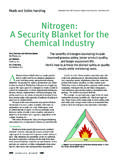Transcription of AIRBRASIVE® Micro Abrasive Blasting Technology
1 2 airbrasive Micro Abrasive Blasting Technology : airbrasive Jet Machining is a process in which high pressure air and very fine powder are blended together in a chamber to form an Abrasive mixture. This mixture is then sent through a small, precisely machined nozzle. The result is a highly accurate Abrasive stream that can be used for cleaning, cutting, drilling, deburring, and finishing all types of surfaces. airbrasive Machines have limitless applications. These highly engineered machines are incredibly versatile. They have the power to cut and drill materials as hard as diamonds, as well as the precision to delicately clean debris from ancient papyrus documents. OPERATING PRINCIPLES The airbrasive Machine is capable of many cutting and abrading tasks. From cutting very hard materials such as diamonds to cleaning extremely delicate items like fabric or paper. The key to taking advantage of its versatility is the knowledge of how it cuts.
2 Knowing this, you can properly set the various controls to achieve your desired cutting results. There are six key variables involved in the cutting process. 1) Air Pressure, 2) Powder Flow Rate, 3) Nozzle Size, 4) Type of Powder, 5) Nozzle Distance from work piece, and 6) Angle of Impingement. AIR PRESSURE The air pressure is directly related to the velocity of the powder particles striking your work piece. The higher the air pressure the faster the particles and the greater the cutting speed. The lower the pressure the, lower the cutting speed. This is not a linear correlation. There are certain critical points you will notice as you experiment with different air pressure settings. When the particle velocity falls below a certain level the cutting action may suddenly stop altogether. Similarly, a small increase in air pressure may gain a large increase in cutting action. The air pressure is limited at the high end by safety concerns and by what your main air supply is capable of producing.
3 The unit should never be pressurized beyond 140 PSI! POWDER FLOW RATE The amount of powder exiting the nozzle per minute is referred to as the flow rate. The greater the flow rate, the greater the cutting action. In order to achieve the better cutting action with higher powder flow rates, it is often necessary to increase the air pressure. This is done to maintain particle velocity which tends to slow down as the mass the air stream must carry increases. Cutting action will decrease quickly at very high powder flow rates. This is due to interference between the powder particles bouncing off the work piece and those coming out of the nozzle. Some brief experimentation at these high flow rates will quickly reveal your limits. NOZZLE SIZE Nozzle orifices are shaped to be either round or rectangular. The nozzle widths vary in size from .005 up to .032 inches. The size of the nozzle determines the area that will be impacted by the powder.
4 The larger the nozzle, the greater the area will be. The shape of the nozzle is important for getting into unusually shaped spaces. A rectangular nozzle can lightly cover a large width or, when turned, heavily impact a narrow space. TYPE OF POWDER The cutting powder is the most important variable in the " airbrasive " process. It determines the severity with which you will impact your part. Some powders are designed for aggressive removal of material while others for a gentle cleaning. In order to achieve consistent, sputter free smooth flow it is necessary to use uniformly sized powder. If the powder particles vary in size, even a little, the powder will have a tendency to clump together. This happens because the smaller particles fill in the gaps between the larger particles, effectively locking them all together. If all the particles are of the same size, then this locking action cannot take place.
5 3 NOZZLE DISTANCE TO WORK PIECE The distance you hold the nozzle from the work piece plays a large part in determining the area covered as well as the cutting rate. ANGLE OF IMPINGEMENT The angle at which you hold the nozzle regulates the speed and efficiency by which material can be removed from the work piece. There are two theories at play here, one based on material removal by brittle failure and the other on material removal by ductile failure. Brittle failure occurs when impacting powder granules penetrate into the work surface and literally blast particles out of it. Ductile failure occurs when the powder granule strikes the work surface at an angle of less than 90 degrees and removes material by generating a chip. Tests have shown that maximum material removal for ductile materials occurs between a 15 and 45 degree angle of incidence. For a brittle material, maximum removal occurs at an angle of 90 degrees.
6 4 Section I: Introduction and Description INTRODUCTION A. Scope. This technical manual contains operation and service instructions, as well as an illustrated parts list for the airbrasive Model K Series II manufactured by S. S. White Technologies, Inc. B. Characteristics. The airbrasive Model K Series II is an electrically powered device that incorporates a patented electro-magnetic vibratory feed system for powder delivery. The Model K series II unit has been designed to accommodate both the intermittent and continuous production demands of high volume producers. SPECIFICATIONS: The specifications of the airbrasive Model K Series II are listed below. 1. Air Supply Requirements 110 30 psi Minimum CFM at 80 psi Maximum 140 psi Dry, clean, compressed air, carbon dioxide, or nitrogen. 2. Electrical Power Requirements AU802 220V, 50HZ, Single Phase, Three Wire The plug supplied is three-prong, polarized, providing an earth ground.
7 3. Weight 33 Lbs. ( ) 4. Dimensions Height 13 " (35 cm) Width 14 " (37 cm) Depth 14 " (38 cm) WARNING The use of oxygen as a gas supply presents the possibility of an explosion occurring. Under no circumstances should oxygen be used. IMPORTANT A suitable dust collector system is required to maintain operator's exposures to powder dusts below permissible exposure limits such as those regulated by OSHA or recommended annually by ACGIH (American Conference of Governmental Industrial Hygienist). Consult the manufacturer of the dust collector equipment for the correct filter for other dusts or air contaminants resulting from material being abraded. 5 AIR SUPPLY NOTE Many compressed air lines are contaminated with moisture, oil, and dirt, which are detrimental to the performance and operation of the Unit. Moisture filters and unloaders must be used. These items can be purchased directly from S S White Technologies, Inc.
8 POWDER NOTE The MODEL K UNIT is designed to use specially prepared powders that are meticulously screened for uniform particle size. These specialty powders insure smooth flow through the many precision ports and feed-throughs. The use of any other type of powder can result in clogging of the internal components and potential damage to the unit. For more information on these powders, contact White Technologies Inc. ( WHITE) or one of its authorized distributors. STANDARD EQUIPMENT Description Part Number Quantity airbrasive Model K AU802 1 Air Supply Hose AT122 5 Feet Nozzle (Rt. Angel, ID( AN118 1 Nozzle (Straight, Round, ID) AN119 1 Nozzle (Straight, Rectangular, ) AN124 1 AccuBrade 27 - Aluminum Oxide AP101 4 lbs. AccuBrade 50 Aluminum Oxide AP105 4 lbs. Funnel AM206 1 Hex T-handle, 3/16 9 AM244 1 IMPORTANT: The airbrasive Model K Series II requires a suitable dust-collecting hood placed near the unit to collect used powder.))
9 White offers dust collectors and work chambers for this purpose. See Product Accessories. WARNING: Do Not Use Oxygen as a gas supply for the unit. An explosion can occur. 6 Section IA: Description of Important Components: See Pages 8-10. 1. SYSTEM POWER ON/OFF SWITCH: The master switch for electrical current supplied to the unit. This will initiate bleeding of all pneumatic lines when switched off during use. Allow a minimum of 20 seconds after turning system power off before attempting to open powder chamber; it takes this long for all pneumatic lines to bleed off and reduce pressure in the chamber to safe levels. 2. POWDER REGULATION ADJUSTMENT: This knob adjusts the voltage being applied to the vibrator/mixing chamber assembly. It regulates the powder flow rate exiting the nozzle 3. POWDER REGULATION GAUGE: A relative measurement of how much powder is entering the flow stream.
10 The gauge measures voltage being applied to the vibrator/mixing chamber assembly. The higher the voltage, the greater the vibration and resultant powder flow. 4. CHAMBER PRESSURE GAUGE: A measure of the air pressure in the mixing chamber, auxiliary chamber. This is the air pressure that will be seen at the nozzle. Do not attempt to open auxiliary chamber to refill powder until this gauge reads "0 psi". This gauge is not field repairable and should be replaced with a new one if it malfunctions 5. CHAMBER PRESSURE ADJUSTMENT: Regulates incoming air line pressure to the desired level in the mixing chamber. This regulates the powder cutting pressure. This regulator is not field repairable. In the event of a malfunction, replace. 6. AIR PRESSURE INDICATOR: This tells you if your incoming air line pressure is available. 7. HAND PIECE HOSE: The hose leaving the pinch tube assembly, passing through the front panel and connecting to the handpiece.







